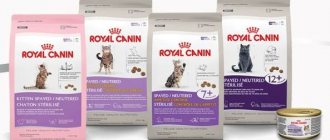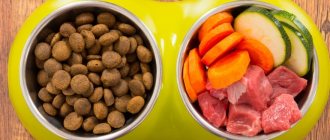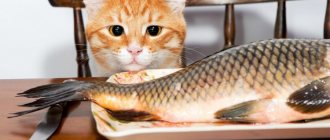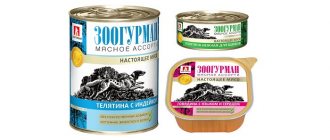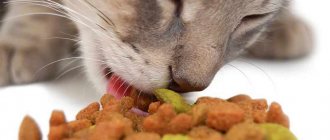Choosing a dry diet as the main food for dogs is a convenient, practical and affordable option that will simplify the life of the owner and maintain the health of the pet. It would seem that everything is simple, you just need to read on the packaging how much food to give your dog, measure out the required amount of dry granules and pour them into a bowl. In reality, many problems and questions arise. From the article you will learn: how the daily intake depends on the energy value and class of food, what to do if the dog does not eat enough of the recommended portion, how much water is needed and when it is necessary to review the amount of food given to the dog.
Should you feed your dog only prepared food or use a mixed diet?
Before we find out exactly what portion of dry food a dog needs every day, let’s find out whether it is possible to feed the dog exclusively with dry granules or canned food. Many owners worry that such a diet is too monotonous and can lead to negative consequences. To avoid this, they switch the pet to a mixed diet - mixing meat directly into a bowl of dry granules or replacing one of the meals with natural products.
Let's highlight the main risks that a dog's mixed diet carries:
- the combination of dry food and meat products can lead to excess protein. Its excess puts additional stress on the kidneys and liver. The result is kidney failure, liver dystrophy, allergic reactions;
- the combination of dry pellets and fish leads to an excess of phosphorus. The result may be urolithiasis. In addition, there is a critical decrease in the level of leukocytes. Minor hemorrhages appear. Bones lose calcium and accumulate phosphates. In adults this leads to osteoporosis, in children to rickets;
- a mix of dry food and porridge leads to an excess of carbohydrates in the body. This situation threatens the rapid development of obesity and all the ensuing consequences.
Constant menu changes actually terrorize the gastrointestinal tract, forcing it to produce different types of enzymes. Such intense work leads to gastritis and peptic ulcers.
Opponents of dry food talk about the risks that a monoration poses. First of all, they note a negative effect on the mucous membranes, especially when the daily norm is exceeded. Despite the qualitative differences in dry diets depending on the class to which they belong, there is no negative effect on the mucous membranes. Before entering the market, all dry food undergoes laboratory testing. All of them are produced with a monoration in mind, so high-quality products contain the entire necessary set of minerals, vitamins and microelements.
Important: of course, it is worth considering the presence of diseases in your pet. Particular attention should be paid to gastrointestinal problems. If a veterinarian recommends giving up dry food and switching to a natural diet, this must be done.
Why do you need to define the norm?
Determining the daily feeding rate is very important. Overfeeding or underfeeding will lead to health problems. Dogs cannot control their food intake on their own. Some breeds, such as pugs or dachshunds, will eat whatever is in their bowl. This behavior has a genetic reason - in nature, the ancestors of dogs did not get prey every day. Of course, domestic dogs are freed from the need to get their own food, but unlimited access to dry food leads to excessive consumption.
Interesting: some manufacturers put a special measuring cup in the package with dry food, which is very convenient for measuring portions for your pet. It is worth remembering that such measuring containers are only suitable for granules from a certain manufacturer and cannot be used for others.
Selecting dry dog food and calculating serving size
Each dog is unique, so many factors influence how much dry food you need.
Class and brand of food
⋅ Economy class food is made from offal and grains, it does not contain meat. Its energy value is 280-320 Kcal. When choosing this food, it is necessary to introduce vitamin and mineral supplements into the animal’s diet. The portion of such food is the largest. In addition, unscrupulous manufacturers often write on the packaging a composition that does not correspond to reality, increasing the dose of certain ingredients or even replacing them with better ones.
⋅ Premium food is made with the addition of meat. Its energy value is 320-400 Kcal. Such food is more recommended by veterinarians and experienced breeders than cheaper economy brands.
⋅ Super-premium food is made mainly from meat and is a complete diet. There is no need to add additional nutrients to your dog's food. The energy value of the feed is 400-450 Kcal.
⋅ Holistic food consists of 60% meat. This is the most nutritious diet. A portion of food is the smallest, but its energy value is 400-450 Kcal. However, professionals often say that the holistic class is not very different in its nutritional value from the premium and super-premium classes: the portion of food will not be much smaller, and such food costs more because it belongs to the most premium class.
Dog size
The packaging of each dry dog food should indicate the serving size. It varies depending on the brand and energy value of the product. One serving is usually divided into two meals: morning and evening feeding.
On average, large breed dogs (for example, a German shepherd, weighing 40 kg or more) consume 500 g of premium food and 700-800 g of economy food per day. Feed for them is developed with less calories, because the animal’s metabolism is slow. That is, they eat a lot, but their food is more dietary.
Medium breed dogs (weight from 12 to 40 kg) eat 350-450 g of premium food and 550-650 g of economy class food.
For small breeds, the most high-calorie food is selected due to their excessive activity. Small dogs (for example, Yorkshire terrier, weight up to 12 kg) eat 150-300 g of premium food and 350-400 g of economy food per day.
Calculation of servings for a pregnant dog
During pregnancy and lactation, the dog uses more energy. Starting from the 42nd day of pregnancy, the animal's portions of dry food and water increase by 25-50%. Provide your pregnant or lactating dog with constant access to food. In this case, you don’t have to follow the diet if your animal is not prone to obesity. Puppies and feeding will use up extra calories, and fasting during this period is much more dangerous. However, still weigh your animal regularly to minimize risks.
Age restrictions when calculating portions of dry food
Animal energy expenditure changes with age. Puppies are active, they are growing and they need high-calorie food and increased portions. As dogs reach the age of seven, they become calmer, their energy levels decrease, and so does their food intake. And in large breeds, for example, Great Danes, the aging process can begin at two years of age. In any case, you either stick to the lower limit when calculating the portion of food, or transfer the dog to a special food marked Senior.
Calculation of portions for dogs with an active lifestyle
Not all of our pets are homebodies. Some dogs lead an active lifestyle: they serve, participate in exhibitions. The activity level of these animals exceeds the statistical average. Constant physical activity increases energy consumption. In this case, the portion of dry food must be increased by ⅓.
Seasonality as an indicator of dog feeding
Service dogs work regardless of whether the weather outside is good or bad. Animals often do their fasting outside and in the cold season the dog spends more energy. The body consumes additional nutrients to maintain heat. The portion of dry animal food must be increased by ⅓ in the cold season and reduced by ⅓ in the warm season.
An adult dog should not be fed more than twice a day. Overfeeding can lead to obesity, which increases the risk of cardiovascular disease and musculoskeletal problems.
It is important to understand that food for your pet is not an expense item on which you should save. The composition of cheap and expensive feeds is very different from each other. Thus, economy class food contains blood, bones, hooves, horns, modified soybeans and vegetable cake. Premium and super-premium food is more natural; it consists of meat, offal, skin, bones, grains and vegetables. Experienced breeders and veterinarians recommend feeding dogs more expensive, but more natural food.
If a dog has health problems, the selection of the right food must be done under the supervision of a veterinarian. He will choose a diet food that will not harm your pet.
Another nuance that is worth clarifying: you should not mix food of different brands when feeding. You should buy food from a specific manufacturer that suits your dog and takes into account all its individual characteristics. Mixing food of different brands, as well as mixing dried and natural food, can lead to an imbalance of vitamins in the animal’s body and disruption of the functions of the digestive system.
How to calculate the amount of food for a pet
Since we are talking about ready-made food rations: dry and wet, we will need to take as a basis tables with recommended daily intakes placed by manufacturers on food packaging. However, the owner will have to take into account a number of individual factors that distinguish his dog. These include:
- Age category of the dog (puppy, young or elderly dog);
- Weight (can be normal, overweight or underweight);
- Dog activity (number and duration of walks, physical activity during the day);
- State of health (presence of chronic diseases, pathologies);
- Physiological condition (pregnancy, lactating bitch, recovery from illness or surgery, and others).
The tables from the manufacturer indicate the recommended daily intake of dry food. Quite often they are significantly overestimated; manufacturers are simply not able to take into account all the characteristics of your pet.
It is necessary to collect all individual information about the dog and determine the brand of food for which the calculation will be made. It is better if dry food is selected by the owner together with a veterinarian, since it is not always possible to independently take into account all the medical contraindications of the animal. The use of a dry diet can lead to serious kidney problems and a serious allergic reaction - advice from a specialist in selecting food and determining the portion size is simply necessary.
How to correctly calculate portions when feeding dogs
The amount of dog food depends on several factors:
- pet breed;
- weight characteristics;
- lifestyle;
- age of the animal.
It is quite natural that large-sized individuals (Alabai, bulldogs, German shepherds, Labradors) require twice as much food as indoor ones (Spitz, pugs, Chihuahuas, miniature pinschers, Yorkies).
An adult animal should be given up to 1 kg of dry food per day, while a puppy should be given 200 g.
If a dog is kept only outside, then its appetite is higher than that of a relative who is only taken out into the fresh air for a walk. Under mixed conditions of detention, you need to select your own nutritional standards. Active individuals burn energy twice as fast as lazy ones.
Over time, metabolism changes and digestion takes longer. Some processes fade away, causing irreversible metamorphoses in the body. Dry and roughage food should be replaced with liquid and semi-liquid food in order to be better absorbed.
Whatever type the animal belongs to, the rule remains the same - you should never overfeed it.
Feeding professionals believe that for an adult the daily intake should be no more than 1 kg of dry food.
You can divide portions into several meals, taking into account the class of food: economy, premium, holistic. The higher the brand of food developed by the manufacturer, the less it will be needed for one individual. It is also worth considering physical characteristics: large breed dogs eat much more than indoor dogs.
It is normal for your pet to feel hungry during the day. The main indicators that the food has been selected correctly are a healthy coat and body weight at which the dog can lead an active lifestyle.
Types of dog food
One of the most important indicators of dry food is its relationship to a certain class and the energy value of such a diet. There are types of dry food:
| View | Energy value (Kcal/100 g) | Compound | Recommendations | Example |
| Economy | 250-300 | Poor composition, based on grains and corn. Contains aromatic additives and dyes. A large portion is needed to satiate the dog. | Should not be used for regular feeding of dogs. Requires the use of additional vitamin and mineral complexes. | Chappie, Oscar, Meal, Favorite, Our brand, ProTail, Darling, Pedigree. |
| Premium | 300-350 | Higher protein content (about 20%), mainly due to offal and meat production waste. The composition contains vitamins and minerals, fiber. | Suitable for everyday nutrition, requires vitamin supplements adjusted for the physiological state of the dog. | Royal Canin, Brit Premium, Monge, |
| Super premium | 360-450 | The most balanced diet, with a minimum content or complete replacement of grains, a maximum content of meat (up to 75%). A complete complex of vitamins and minerals. | Suitable for daily feeding of dogs, no additional feeding is needed. | Akana, Eukanuba, Grandorf. |
| Holistic | 360-450 | Difference from the super premium class: the ingredients that make up the food are approved for use in the human food industry. | Maximum benefits, recommended for use in dog nutrition. | Landor, G.O., Canidae, Grandin. |
The daily amount is indicated by the manufacturer based on the normal physiological weight of the animal, and not the actual weight. If your dog weighs much more than is expected for a certain age, this is a reason to contact the veterinarian.
There is no direct relationship between the amount of dry kibble in your pet's bowl and how quickly he becomes satiated. A dog can eat a “bucket” of economy class pellets and remain hungry. Don’t think that buying low-grade food will save you money.
Energy value of different classes of feed
The class of feed is determined based on its composition and energy value, which ultimately affects the price of the product. The dog owner can purchase economy, premium, super-premium or holistic food. Each of them has its own characteristic features.
Economy
The ingredients for this type of feed are usually low-quality raw materials in the form of cereals, soybeans, meat and bone meal and by-products with low nutritional value. The content of vitamins and minerals useful for dogs is minimal, so in fact a lot of food is consumed, but there is little benefit from it. Low digestibility and high carbohydrate content have a negative effect on the dog’s body, over time causing allergic reactions, delays in the animal’s physical development and deterioration in its appearance. To avoid the negative consequences of such feeding, you will have to additionally introduce meat and vegetables into your pet’s diet.
The energy value of economy class dry food does not exceed 320 kcal per 100 g of product, taking into account which the daily food intake is determined:
| Dog size | Feed consumption per day |
| small breeds (up to 12 kg) | 180–200 g |
| medium (12–40 kg) | 300–500 g |
| large (more than 40 kg) | 600–750 g |
Today’s popular brands of economy-class dry food are deservedly considered “Pedigree”, “Our Brand”, “Chappy”.
Dry food
There are average feeding rates, according to which the daily dose is divided by the number of feedings. Most often, this standard is indicated in grams or in the number of measuring cups. 1 measuring cup = 240 ml (about 100 grams).
If necessary, dry granules can be softened with liquid: for puppies under 4 months of age, for older dogs or those with gastrointestinal problems.
I do this with different liquids depending on the dog’s preferences.
You should not prepare a large portion of soaked food, so as not to throw away an expensive product. Experts note that in the warm season, many animals refuse the softened product, preferring to drink dry granules with water.
Useful tips
Experienced poultry farmers advise how to increase the productivity of laying hens:
- Give partially sprouted grain . This is especially necessary in the winter season when chickens do not have enough grass. Sprout approximately 1/3 of the grain that makes up the diet.
- Give your chickens only tasty food. The bird does not like food with a specific taste and smell. If you give them food that doesn't taste good, they will simply refuse to eat.
- Increase the calorie intake for pullets . During puberty, a chicken's body experiences stress. Thanks to increased feeding rates, the chicken will show high starting egg production.
- Give your bird clean water . Thirst negatively affects the productivity of chickens. The water is first boiled and then cooled. Raw water contains bacteria.
To get a lot of large and tasty eggs from chickens, you need to study the rules of feeding and keeping birds. By being attentive to laying hens, adjusting their diet depending on age and time of year, you can maintain the birds’ egg production at a high level all year round.
0
Rules for soaking dry food
If for some reason the amount of dry food is soaked, it is recommended to adhere to the following rules:
- use clean drinking water (can be bottled or filtered), but not boiled. Temperature - 40°C;
- The ratio of liquid to dry product depends on the preferences and age of the dog, and the manufacturer’s recommendations. Possible ratios (water:feed) - 1:2, 1:3;
- In addition to water, you can use low-fat fermented milk products - yogurt or kefir. The diluent should not be sweet, the temperature should be room temperature;
- the daily feed intake is not increased or decreased. Only the consistency of the portion changes.
Important: soaked dry food should be eaten within 2-3 hours. At any temperature, such food quickly sours and is inseminated by bacterial flora. If fermented milk products are used, it is necessary to carefully monitor the animal's stool. Minor liquefaction that resolves quickly should not cause alarm. If diarrhea continues for a long time, it is necessary to stop soaking dry food and consult a veterinarian.
The manufacturer may set a limit on the soaking of dry granules, which should be noted on the food packaging.
Photo: pixabay.com
How to calculate the dosage of dog food per day
If you focus only on the weight of your pet, then you can adhere to the above standards for feeding dry food, with mandatory consideration of their class. However, in some cases it is possible to adjust these values up or down. In the first case, this is required if:
- the dog is subjected to increased physical activity or is simply very active (increasing the food intake is at the discretion of the owner, but in any case the pet should not be allowed to overeat);
- the female is pregnant or nursing puppies (the daily norm increases on average by 1.5 times);
- the animal looks thin or emaciated, even when consuming a normal amount of food in accordance with its body weight (increasing the portion is at the discretion of the owner, however, you first need to make sure that the animal does not have health problems).
Did you know? The greyhound Star Title is deservedly considered the fastest dog in the history of recent decades. In 1994, the animal set an absolute world record, accelerating to 67.32 km/h.
In some cases, the given norm of dry food of the selected class may be too much for a particular dog, for which there are always several reasons:
- genetic predisposition to excessive weight gain (typical of Labradors, Rottweilers, French bulldogs);
- age-related changes in the body, in particular due to a slowdown in metabolic processes due to a decrease in the activity of the animal;
- the postoperative period or rehabilitation after a serious illness, when it is desirable to return the dog to its usual diet gradually, without overloading its stomach.
Small puppies and young animals usually spend much more calories than adults and fully developed relatives, so the daily food intake for a puppy under the age of 6-7 months should be one and a half times higher than the norm for adult animals. The instructions on the packaging will help you avoid mistakes: on average, a serving for large breed babies is 600–900 g of premium food or 900–1200 g of cheaper economy products, while representatives of small breeds eat 200–400 g or 450–600 g per day g of feed mixture, respectively. For one medium-sized pet, 600–800 g of economy class food or 450–600 g of premium food per day is sufficient.
Wet food
Soft canned food has exactly the same division into classes as dry food. This means that the higher the class of food, the greater its energy and nutritional value, which means that less of it will be needed to saturate.
However, it is not recommended to completely switch the animal to feeding canned foods - soft food can cause problems with the gastrointestinal tract, constipation or loose stools, and the risk of tartar formation increases, since there is no mechanical cleaning of plaque.
| Type of dog | Daily calorie requirement (kcal) | Combined diet (dry + wet) (g) Pedigree | Only wet (100%) (gr) Using Pedigri as an example |
| Miniature (2-5 kg) | 250-350 | 40-50 | 300-400 |
| Small (6-10 kg) | 360-550 | 50-100 | 400-700 |
| Medium (12-24 kg) | 600-1050 | 100-250 | 800-1300 |
| Large (26-40 kg) | 1100-1550 | 200-300 | 1400-2000 |
| Very large (45+ kg) | 1600-2500 | 300-550 | 2050-6000 |
Daily food intake for puppies
| Puppy age (in months) | Number of meals per day | Daily kcal norm per 1 kg of weight in |
| Up to 1 | 6 | 220-250 |
| 1-3 | 5 | 260-280 |
| 3-4 | 4 | 200-230 |
| 4-8 | 3-4 | 120-150 |
| 8-12 | 2-3 | 100-130 |
Small breeds of puppies
Puppies of small and miniature breeds develop very quickly due to increased metabolism; at 6 months, such a miniature dog puppy is already very similar to an adult dog. Therefore, during the period of intensive growth, such babies need high-calorie food, which allows the animal’s body to properly form in such a short time.
| Age\weight (months) dog weight up to 10 kg | Super premium diet (using Akana as an example, value about 450 kcal) | Economy (using the example of Our Brand, value about 300 kcal) |
| 1-3 | 15-80 gr | 45-100 gr |
| 3-4 | 17-115 g | 60-200 gr |
| 4-6 | 20-120 gr | 70-250 gr |
| 6-12 | 25-125 gr | Feed used for adult animals |
Photo: flickr.com
Large breeds of puppies
Large breed dog puppies need a diet rich in protein and calcium for muscle growth and healthy skeletal development. Their development occurs spasmodically, at six months of age they look more like ugly ducklings rather than adult dogs. The heart muscle also requires special nutrition, which must receive all the necessary elements for further uninterrupted operation.
| Dog's age/weight | Super premium diet, value 400 kcal (using Grandorf as an example) | Economy food, value 300 kcal (using the example of Pedigree) |
| 1-3 (from 5 to 70 kg) | 50-220 gr | 400 gr |
| 3-4 (from 25 to 70 kg) | 230-330 gr | 450-530 gr |
| 4-6 (from 25 to 70 kg) | 260-500 gr | 550-600 gr |
| 6-12 (from 25 kg) | 250-800 gr | 650-900 gr |
Recommended feeding rates
The daily amount of dog food is calculated based on several factors:
- pet's weight;
- age;
- activity;
- tendency to gain excess weight.
How many days before vaccination should a cat be given anthelmintic?
These indicators are the most important when creating a dog’s diet.
Important! You need to understand that large dogs, such as a husky or a Labrador, will need more food than a Pomeranian.
However, there are some other points to consider:
- presence of pregnancy;
- growth rate (varies among different breeds);
- the presence of diseases or the duration of the recovery period;
- living conditions (animals living outside require more nutrients, especially in winter).
Note! When preparing a diet, you can also consult a veterinarian.
In general, the average daily intake of dry food for adult animals, depending on weight and physical activity, can range from 200 to 900 g per day. In this case, the dog needs to be fed 2 times a day.
Do not exceed the amount of dry food to avoid overeating
For service dogs and athletes, it may be necessary to increase the portion by ⅓ of the total dosage; for pregnant bitches, the amount of food is increased by a quarter. For older dogs, on the contrary, the portion should be reduced by ⅓.
Puppies are fed much more often. At the age of up to 2 months, the frequency is 5-6 times a day, at 3 months - 4-5 times. At the age of 4 months to six months, 3-4 feedings are sufficient. From 6 months to a year, food is given three times a day; after a year, the dog is already an adult, and the frequency of feeding should be appropriate.
Many owners often have a question about how many grams of food per day should be given to the puppy. The amount of food for babies depends on the breed and weight. For small dogs, the portion will be smaller than for puppies of larger breeds. To correctly calculate the amount of food for babies, you will need to know their weight and calorie content of food. Approximate data per 1 kg of weight can be seen in the table below.
| Age | Calorie content (kcal per 100 g) |
| Up to 1 month | 220 |
| Up to 3 months | 270 |
| Up to six months | 150 |
| Up to a year | 120 |
Note! For very young puppies, dry food should be soaked a little in water to avoid damage to the teeth.
On each food package, the manufacturer indicates the recommended amount for the dog depending on its weight. However, you cannot be completely guided by these parameters, because each dog is individual.
The norm for puppies also depends on the weight and age of the baby
Daily food intake for adult dogs
| Normal dog weight (kg) | Norm of dry granules per day (g) with normal activity | Norm for high animal activity (in g) |
| 1.5-6 | 50-110 | 100-200 |
| 6-10 | 115-150 | 215-290 |
| 10-16 | 155-230 | 300-410 |
| 16-23 | 235-290 | 420-550 |
| 23-35 | 295-400 | 560-630 |
| 36-45 | 410-500 | 700-900 |
| 45+ | 510 + 50 g/ 5 kg weight | 800 + 100 g\ 5 kg weight |
For a pregnant bitch, the daily intake of an adult dog (by weight) is increased by 25-50% depending on appetite, in consultation with a veterinarian. It may be worth giving up food intended for adult dogs and using a diet for puppies. A portion of such food is calculated according to the rule: the daily norm of an adult healthy individual with normal activity + 25-50%.
Number of feedings and volume of portions depending on age
A young and an adult animal needs different amounts of energy consumed. It is logical that the number of approaches to the bowl and the portions themselves will not match between two generations. Now we will try to find out how much dry food a dog should be given per day, based only on its age.
For adult dogs
A pet that has reached the age of one is considered an adult. From this point on, he must be slowly transferred to two meals a day.
And since you will have to feed the dog less than usual, the question will arise about creating the correct portion size so as not to overfeed the dog, but also not to leave him hungry.
| Daily value for an adult dog | |
| Feed class | Volume of one serving (g) |
| Superpremium | 300-400 |
| Premium | 500 |
| Economy | 700 |
For puppies
Puppies eat more often than adult dogs, but as they grow older, the number of meals decreases, but the portions, on the contrary, become larger. We offer you a detailed table that shows how many times a day to feed a puppy from 1 month to a year and a half.
| Age | Quantity | Single serving (g) |
| 1-2 months | 7 | 100-200 |
| 2-3 months | 6 | 150-200 |
| 3-4 months | 5 | 250-450 |
| 4-8 months | 4 | 500-800 |
| 8-1 years | 2-3 | 800-1200 |
| Over 1.5 years | 2 | 1500-2000 |
For pregnant and lactating women
To ensure that pregnant and lactating dogs, and with them puppies, receive everything they need for full functioning, change their diet. From the 5th week of gestation, gradually increase (and so on every 7 days) the amount of the daily norm. By week 9, the daily amount of food should be 1/3 more than usual.
After giving birth, in the first 3 weeks, the new mother must eat intensively, so feed her three times a day.
Starting from 4 weeks, feeding is increased to 4 times a day. Serving sizes will also vary:
Week No. 1 – 150% of the usual serving volume.
Week No. 2 – 200% of normal.
Week No. 3 – 300% of the usual size.
Daily food intake for older dogs
Upon reaching the age of seven, the pet needs to review its diet and the amount of food consumed. During this period, chronic diseases and pathologies worsen, and metabolism slows down. The dog needs additional minerals, but not an increase in food portions. It is worth changing the food, choosing one that contains special markings.
Let us note that with age, most animals’ need for rest and sleep increases, but food preferences change greatly: from uncontrolled food consumption to refusal of it.
If your dog has problems with the gastrointestinal tract or teeth, you should start soaking the granules or switch to wet canned food.
| Dog weight (over 7 years old) in kg | Daily value (in g) | Daily value in a cup (1 measuring cup about 100 g) |
| 1,5-5.5 | 35-100 | 1\3-1 |
| 5,5-9,5 | 110-150 | 1-1,5 |
| 10-15 | 160-210 | 1,5-2 |
| 16-23 | 220-300 | 2-3 |
| 24-35 | 310-380 | 3-3,5 |
| 36-45 | 390-470 | 4-4,7 |
| 45+ | 480 + 50 g/ 5 kg | 5+ |
How much water does a dog need when eating dry food?
Water is the basis for proper digestion and metabolism. In order for your dog’s body to receive all the necessary substances from their dry food, you must strictly follow the rules for providing it with water:
- The daily water intake depends on the dog’s weight and the portion of dry food consumed;
- For 1 kg of animal weight, about 40-60 ml of water is required;
- Puppies need more fluid - about 80-100 ml per kg;
- Monitor your pet's behavior - if he eats exclusively dry food, he may need more water than normal;
- If the ambient temperature drops below +20, the dog can reduce its fluid intake.
A bowl of clean, fresh water should always be available to your dog. Monitor your fluid intake - deviations from normal behavior should alert you and this is a reason to consult a doctor. Don't get dehydrated!
Photo: wikimedia.org
Portion volume
If your pet eats dry food, then there are usually no problems with determining the daily serving amount. Many manufacturers of dog food mixtures already indicate the required amount on the packaging - it is indicated in the form of a plate in which the feeding rate is indicated opposite the weight.
To determine the amount of dry food needed, the owner needs to know the weight of the animal. Then the specified amount must be divided by the number of feedings per day. The result is the volume of a single serving.
If the dog eats only natural food, then the calculation is performed completely differently. The daily intake for natural feeding should be about 2-4% of the pet’s total weight. For example, if a dog weighs 8 kilograms, then he should eat an average of 160-320 grams of food per day.
However, the numbers may depend on many factors - the animal’s physical activity, lifestyle, and living conditions. In addition, the nutritional value of prepared dishes can affect the size of portions; for example, porridge with vegetables will be much lower in calorie content than meat.
If a dog eats natural food, its diet should include the following types of food:
- meat. The indicator of this component should be 30-50% of the total volume of food consumed;
- cereals – 25-35%;
- dairy products – 20-30%;
- vegetables – 15-20%;
- fish;
- fruits.
Learn about dog food allergies>>>
If the dog does not eat enough dry food
All these rather complex and sometimes inaccurate calculations are needed to ensure that the dog does not starve and receives the maximum amount of nutrients from the food it eats. Of course, if a dog is constantly begging for treats and food from the owner’s table, this does not mean that the portion of food is not enough for him. However, you should carefully ensure that the offered portion is enough. Symptoms of deficiency may include:
- after feeding, the dog does not leave the bowl, freezes, waiting for more;
- the dog’s ribs, pelvic bones and scapular edges are clearly visible;
- the hunger pit is pronounced;
- the fat layer is thin.
These signs indicate that the dog is underweight. This can be either a consequence of the disease or insufficient nutritional value of the daily diet. In this case, the owner must:
- Visit your veterinarian to rule out your pet losing weight as a result of illness. For example, infections with parasites;
- if the dog receives super premium or holistic food, it is worth increasing the portion. Perhaps the animal’s physical activity has increased, its physiological state has changed, the cold season has arrived - all these are reasons to increase the proportion of dry granules in the bowl;
- if feeding is carried out with a diet of a lower class, choose higher quality, high-calorie and energy-rich dry food. It is better to choose an option, buying it in small packages in order to choose exactly what your dog will like;
- You can switch your dog to a mixed diet according to the following scheme: wet canned food + dry granules. Canned food is more nutritious and is often more appealing to animals.
Required Products
Putting together a food basket for the average dog is quite simple, but you need to consider which specific ingredients are most suitable for the breed. These details are usually clarified with the breeder or discussed with the veterinarian. When compiling a list of dishes, the dog’s personal preferences, as well as possible allergic reactions, are taken into account.
When introducing a new product, add it to your daily diet gradually and carefully monitor the reaction. If any component causes vomiting or diarrhea, then either you fed more than necessary, or your stomach is simply unable to digest. Cancel and try again after a while in small portions.
Meat
Not every cut of any animal is suitable for a dog's dinner. The ideal choice would be 1st grade lean beef . At the same time, there is no point in trying to select the best pieces. The same cutting will not bring much benefit. Lamb, rabbit, horse meat and venison are also excellent for feeding animals. In this case, it is necessary to choose pieces without fat and take into account that lamb and rabbit meat are higher in calories than beef and veal.
READ ALSO: How much meat does a dog need per day?
Pork is not suitable for dogs to eat . This is too fatty and heavy meat, which is not digestible and cannot be digested normally, which means it will not bring any benefit, only increasing the load on the liver and gall bladder.
Meat products are usually fed raw, but before that they must be frozen at a temperature no higher than -20 in order to destroy all possible pathogens or parasite larvae. If this is not possible, then it is best to boil the pieces served to the dog.
Bird
One of the options for a variety of meals 1-2 times a week can be poultry. Usually this is chicken or turkey, the rest usually have too fatty meat, absolutely not suitable for feeding four-legged friends.
When choosing the part to be fed, it is worth removing fat and skin, since they are not allowed for dogs. It is also worth paying special attention to preparation. If regular meat is given raw, then it is preferable to cook the poultry, even if it has been frozen. In this case, we are not talking about possible infection with internal parasites or any disease, but about the effects of hormones that are actively used in feeding birds.
The daily dose of poultry meat is slightly higher than beef, since it is a more dietary option with lower caloric intake.
By-products and tripe
Another necessary part of the diet are various offal products. Here it is possible to use almost any parts of the bodies of animals and birds that are also used by humans. The only exception is pig organs, which are also too heavy for a dog's delicate stomach.
Offal is also served raw after careful freezing, taking into account that the portion should be larger than the standard one, since they are less nutritious.
Giblets cannot completely replace muscle tissue in the daily diet, but they can be given 1-2 times a week as a separate meal.
A special place on the list is occupied by liver, especially beef, and tripe. Liver, raw or boiled, is a wonderful treat that can be used to pamper your pet during walks and exercises without any consequences and to the great pleasure of the dogs who love it. Tripe, or raw cow stomach, is often used from a very young age to gradually accustom the puppy to meat components. Also, in its raw form, scar is needed to establish the microflora of the gastrointestinal tract.
READ ALSO: Types of offal for feeding dogs
Cereals
This part of the diet is the second most important, since it is the main source of slow carbohydrates that fill your pet with energy throughout the day.
Rice, buckwheat, oatmeal, and oats are the traditional basis for dog porridge. However, before giving it, it is worth checking with your veterinarian whether a particular type of cereal is suitable for your breed.
Most cereals are not digested or absorbed, which means it is useless to try to feed them to an animal.
Vegetables and fruits
The most standard, familiar vegetables and unsweetened fruits are selected. Carrots, cabbage, cucumber, zucchini, bell peppers, pumpkin and other familiar options, grated, the dog will eat with great pleasure along with the meat part. It is dangerous to give potatoes, corn and other foods containing a large percentage of starch.
Ideal fruits are unsweetened apples and pears. Citrus and exotic fruits should be avoided.
Why is underfeeding bad?
If exceeding the norm threatens obesity, then what is wrong with underfeeding? A deficiency of nutrients that the dog does not receive from the daily diet will have a bad effect on the dog’s health - the animal’s bones and internal organs will suffer. This is especially true for pregnant and lactating bitches. Underfeeding is dangerous for a puppy or a bitch that has just given birth.
During the period of feeding puppies, the feeding rate is increased - in this case, the food can be left in the animal’s bowl without restricting it. Even if she eats 200% of her daily allowance, that's okay. Malnutrition threatens not only the deterioration of the health of the mother with a tail, but also of the puppies, since the quality of milk decreases.
Important: if during the feeding period the bitch cannot eat a lot of food, and she loses weight, it is worth consulting a specialist. It would be better to switch the animal to a higher-calorie type of dry food.
Briefly about the main thing
- Super premium and holistic dry food is best suited for feeding a dog;
- Dry food is digested much faster than natural food - it is worth feeding the animal three times a day in small portions, dividing the daily intake by the number of feedings;
- The dog’s diet should be based on its age, weight, health status and other individual characteristics;
- You can combine dry granules and wet canned food;
- The manufacturer provides the recommended serving size, it is a guideline;
- Small and large breed dogs have different nutritional needs;
- The dog should always have clean, fresh water available.
How do you calculate the required portion of food for your pet? Which food was chosen: economy or super premium? What differences in serving size have you seen? Share your experience in the comments to the article, please. Your opinion is very important to us.
How many times a day do you feed a dog?
The frequency directly depends on the age of the animal. Puppies are given shorter intervals between feedings and a larger number of meals.
Puppy
From the age of three weeks, puppies begin to be accustomed to solid food. The number of feedings reaches 5-6 times a day.
Once the puppy reaches two months of age, the number of feedings is reduced to 3-4, after six months of age - to 2. Animals one year old and older, depending on their physical condition, are fed twice a day.
Adult
An adult dog is fed twice a day – in the morning and in the evening. It is necessary to observe a strict interval between serving food - 12 hours - and not move it under any circumstances. The regime can be broken if you need to fast before tests or surgery.
For pregnant females, the frequency of feedings is increased only in extreme cases - usually an increase in portion size is enough.
Adult dogs are fed three to six times a day if they are on a diet to treat a serious illness. When the pet’s well-being improves, the pet is transferred to the usual two meals a day.


